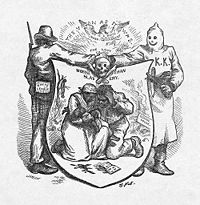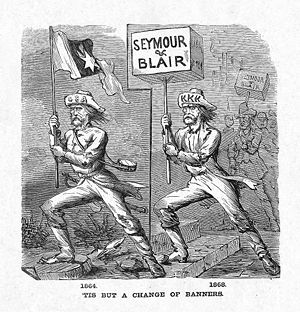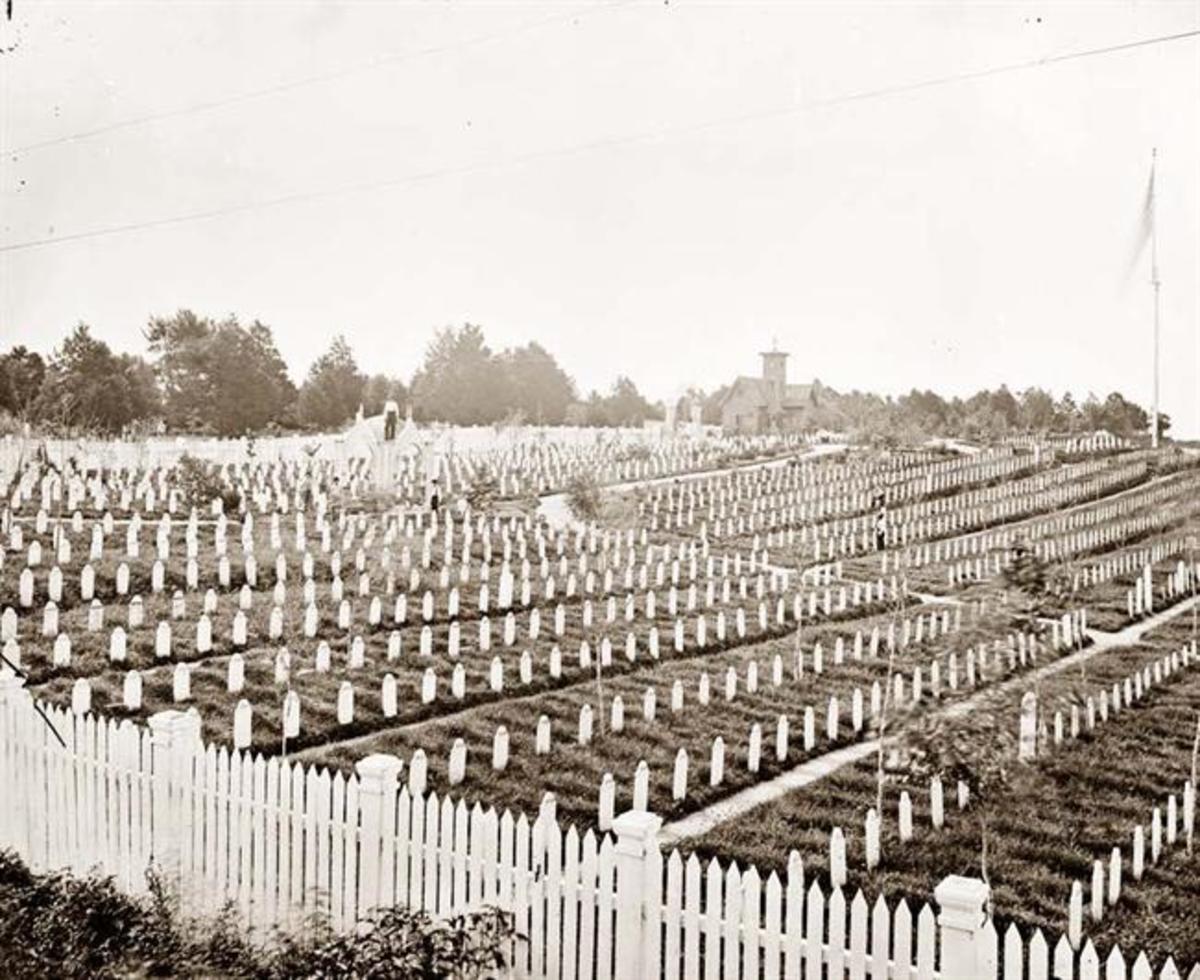US Policy and Counter Insurgency During the Post Civil War Reconstruction Period
Newspaper Images from the Reconstruction Era


The Post Civil War Reconstruction Era should have leveraged all the powers of national government in order to incorporate the Southern 'fold" back into the national fabric while simultaneously protecting the recently granted constitutional rights of over four million freed slaves. This period was undoubtedly full of potential for prosperity; but unfortunately proved to be just the opposite, an abysmal failure full of false hope, corruption, and violence along racial political lines.
The American Civil War had cost the Nation's Economy an estimated six billion dollars, approximately 81 billion in today's dollars.[1] The war exponentially amplified the effects of the industrial revolution creating a significant shift of capital from the agricultural economy of the South to the Industrial North.[2] In 1860 six of the ten wealthiest states in the United States were in the South; by 1880, not one southern state was in the top half.[3] The South lost over 2 billion in capital or over 66% of its total wealth. The banking system in the South was destroyed; by 1869 only126 banks existed throughout the entire former Confederacy.[4] The human toll was even more costly, the South lost 260,000 men, 25% of the white male population, and another 500,000 former Confederate soldiers were unemployed, many severely crippled; 25% of all Confederate soldiers were permanently injured[5]. One Georgian summarized the desperate situation as, "We have no currency, no law, save the primitive code that might makes right ..... the props that hold society are broken."[6]
This sudden societal shift and economic disparity soon resulted in upheaval. In Memphis, during April 1866, mobs backed by local Memphis police attacked, resulting in over $100,000 in destroyed property, with 30 dead and another 50 wounded.[7] In New Orleans, on July 20, a crowd led by local law enforcement, attacked black republican supporters leaving 38 dead and 146 injured. General Sheridan, responsible for the military district which included New Orleans, telegraphed Grant on August 2, "It was no riot. It was an absolute massacre by the police ... It was a murder which the mayor and the police of the city perpetrated without the shadow of a necessity. Furthermore, I believe it was premeditated, and every indication points to this."[8]
Congress, realizing that the security situation was crumbling, established a Joint Committee to investigate Reconstruction Policy. In March of 1867, the Reconstruction Act was passed which reinstating martial law; dividing the former Confederacy into five military districts and granting the Army the power to remove and appoint officials, register voters, hold elections, regulate court proceedings, and approve state constitutions.[9] Once a state constitutional convention was elected, it had to establish a new state government and ratify the Fourteenth Amendment. Once these terms were met, the southern states could apply to Congress for readmission into the Union.[10] Once a state was reinstated the military no longer had the authority of martial law and now had to use judicial process in order to enforce law and prosecute criminals. The last state to be reentered into the Union was Georgia on July 15, 1870. All of these state governments were republican in nature; which only incited more contempt from the old line Southern 'Conservatives'; who countered with the forming of 'White Leagues'. Reconstruction became a political struggle for the ballot box backed by paramilitary force. The tactics of these 'White Leagues' which included election fraud, bribery, intimidation, and conspiracies once again drew the attention of Congress which passed legislation known as the enforcement acts which made it a Federal crime to deny any citizen of their constitutional rights.[11]
The most notorious group that arose and widely known for its violent activity against both blacks and Republicans was the Ku Klux Klan. One US General on occupation duty in Tennessee wrote, "The Ku Klux organization is so extensive, and so well organized and armed, that is beyond the power of any one to exert any moral influence over them....Powder and ball is the only thing that will put them down."[12] As early as 1868, 1300 Murders were attributed to the Ku Klux Klan.[13] Grant described the tactics of the Klan as "by force and terror, to prevent all political action not in accord with the views of the members, to deprive colored citizens ... of the right of a free ballot ... to reduce the colored people to a condition closely allied to that of slavery."[14] In April of 1871, Congress passed the Ku Klux Klan Act which prohibited attempts to deprive citizens of the right to vote, hold office, serve on juries, and enjoy the equal protection of the laws. If states failed to protect citizens, the federal government would with military intervention and the suspension of habeas corpus.[15] These acts basically declared war on the activities of the Klan and empowered federal agencies, to include the US Army, with the tools needed to go after these terrorist elements.
In June 1870, the Justice Department was established with Judge Amos Ackerman as the Attorney General; bringing together US Marshals and District Attorneys all under one Federal Agency, providing both the means to convict with the means to enforce federal law. The newly minted agency had a great immediate need for more agents; it turned to the Treasury Department receiving 'on loan' Secret Service Agents in order to 'beef up' its force of marshals. Even with the assistance of the Treasury Department, Ackerman knew he did not have enough agents to police the Klan effectively; he began to push the President for US Army support. The US Army has always been constrained from law enforcement activities due to the nature of our American Society, as a soldier, Grant understood this and was understandably reluctant to act.
South Carolina reentered the Union under a Republican Government on July 9, 1868. At the time, the US Army had 881 Soldiers in the state; by 1870 the number was reduced to only 427.[16] The freeman population made up over 50% of the vote within the state. In 1870, less than 1% of the State's population was employed in an industrial capacity and the cash value of farms was now only a third of what it had been prior to the War.[17] The disenfranchised turned to violence, intimidation, and terror in which to regain political power during the state elections of 1871. Governor Scott, the elected Republican Governor of South Carolina, informed the President of the deteriorating situation and requested Federal intervention. President Grant acquiesced and K Troop of the 7th US Cavalry, under the command of Major Lewis Merrill was deployed. Occupation duty was certainly not considered a premier assignment among Army Officers, General Meade, former Commander of the Army of Potomac, reflected this common attitude stating, "vide our friends in the Southern Dept. where you have not only to be a soldier, but must be politician ... not only difficult but, disagreeable."[18] Merrill, a veteran of the Kansas Missouri Border Wars, the Civil War, and Plains Indian Wars, was well known for his meticulous organizational skills and had an uncommon familiarity of law concepts having grown up in a family of attorneys and experience as a judge advocate on several military courts martial.
In late March 1871, Major Merrill assumed command of the post at Yorkville, working under the overall command of Brigadier General Alfred Terry of the Department of the South. During this time, troop levels in South Carolina were nearly doubled to around 1,000 Soldiers. MAJ Merrill began using his authorized treasury funding to 'purchase' informants and build his intelligence networks. He quickly developed an accurate picture of the Klan network, identifying the key leaders. He reported to General Terry on May 4, "I have some hopes of being able to trap some of these scoundrels, and bringing them to punishment. The difficulties are numerous and I am not sanguine about the result, but see so much good to be accomplished by the punishment of even two or three that I shall spare no effort to accomplish it. The tracing and capturing these fellows would be the merest childs play, if I had the authority to go about it as I saw fit, but the necessity of keeping within the lawful limits of peace measures and civil processes hampers every action and complicates every plan."[19]
Major Merrill personally met with the U.S. Attorney of South Carolina, David T. Corbin, and expressed his concerns on his limited authorities to bring the Klan to justice. He also personally met with Attorney General Ackerman, who reported his impression of Merrill as, "resolute, collected, bold, and prudent, with a good legal head."[20] Ackerman made a personal plea to Terry as to the necessity of US Troops to engage in a law enforcement role, due to the local corruption and sympathy for the Klan. General Terry received Major Merrill's reports and understood the issue, he forwarded these reports to the War Department with his own endorsement on June 11, stating, "The whole army of the United States would be insufficient to give protection throughout the South to all those who from time to time are in danger from the members of the Klan. Fortunately, it is not necessary, as I think, to attack the organization at every point. If in a single state it could be suppressed, and in that state exemplary punishment meted out to some of the most prominent criminals, I think that a fatal blow would be given everywhere, or that at any rate the task of suppression elsewhere would thereafter be an easy one. Manifestly, however, military power alone is not sufficient to meet the emergency."[21]
President Grant having received recommendations from both the Department of Justice and his Department of the South Commander, on October 17, suspended the writ of habeas corpus, as provided by the Klan Act, and declared nine South Carolina counties to be in 'open rebellion'. Within two days of receiving the new authority, Major Merrill's Soldiers rounded up eighty-two suspects, by April 1872, 533 suspects were detained and awaiting trail.[22] MAJ Merrill and the Department of Justice were so successful at identifying the members of the Klan, many Klan members voluntarily surrendered. A review of 1872 prosecutions by state exhibits a substantial increase of the rate of convictions; a 90% rate in South Carolina, the highest of all the former Confederate States during the entire Reconstruction Period.[23] The elections of 1872 proved the effectiveness of this interagency cooperation; it was the most peaceful of the reconstruction era.[24]
As the Justice Department took a hard stance on convictions, Mississippi had a 73% conviction rate in 1872, the second highest rate, only exceeded by South Carolina, for the entire South.[25] Mississippi, also with a black voting majority, was well aware of the crack down in South Carolina and was anxious to avoid the same during their upcoming 1875 State elections. Democrats enacted what would be known as the Mississippi Plan; designed by James George, a democratic newspaper editor, and Ethelbert Barksdale, a former Confederate General, who ran Mississippi politics. The Mississippi Plan was to utilize intimidation and coercion in order to suppress the black vote but, not enough actual violence to warrant the use of Federal Troops.[26] Following the success in South Carolina, Mississippi Republican Governor Adelbert Ames requested troops to provide election security; the President, in reflection of declining national sentiment, replied, "The whole public are tired out with these autumnal outbreaks in the South.....and are ready now to condemn any interference on the part of the government."[27] A Mississippi Republican described the desperate situation as, "unless the Government sends troops here at least a month before the Election, the Negros will not go to the polls." Governor Ames resigned under threat of impeachment after Democrats retook the state legislature and was replaced with Democratic Governor Lucius Q. C. Lamar in 1876, achieving the objective of the Mississippi Plan and other Southern States took notice. Only three Southern states remained Republican, South Carolina, Florida, and Louisiana.
The same plan was implemented in South Carolina, which went to democratic control in 1876 under the Governorship of Wade Hampton, the famous Confederate Cavalier of the region. Florida and Louisiana fell to democratic control as President Hayes came to power and made good on his promise to remove all Federal Troops from the South in 1877. Congress went one step further and enacted the Posse Comitatus Act in June 1878, severely limiting the role of the military in domestic law enforcement. The Department of Justice could no longer count on effective support from the U.S. Army. By 1877 the US Marshals had arrested 7,000 under the authorities of the Enforcement Act of 1870 and the Civil Rights Act of 1871.[28] This was negligible when considering a population of 500,000 paroled Confederate Soldiers and considering that MAJ Merrill's efforts netted over 1000, we can see that the Marshalls simply just did not have enough agents.
The overall national policy of reconstruction vacillated throughout the entire era; interagency operations were extremely effective at the tactical level as proven in South Carolina in 1872, when federal policy was executed by an aggressive Attorney General and supported by the US Army. The problem became pronounced as the resolve at the national strategic level weakened over time. This can be seen in both the steady decline of troops and conviction rates after 1873. In 1875, Mississippi only convicted six of 181 under the enforcement acts and no one was convicted in the next two years. In South Carolina, the conviction rate dropped to 3% in 1873 and 0% in 1874.[29] Interagency operations at a national level never came together, because a lack of a 'long term' strategic national policy. The Secretary of Interior Cox, eluded to the overall lack of synchronization toward the goal of a reconstructed South, when he stated, "my own Department keeps me busy enough, but one can't help feeling that we ought to have a common policy on which the administration should be a unit and not drift into a bureaucracy in which each Department minds only its own business, as we are doing."[30]
[1] Jack Beatty, Age of Betrayal (New York: First Vintage Books, 2008), 54.
[2] Kevin Phillips, Wealth and Democracy (New York: Broadway Books, 2002), 32-33.
[3] Jack Beatty, Age of Betrayal (New York: First Vintage Books, 2008), 57.
[4] Jack Beatty, Age of Betrayal (New York: First Vintage Books, 2008), 79.
[5] Secrets of the Civil War, US News and World Report Collector's Edition, 'The Terrible Cost of the War" 20.
[6] Dan T. Carter, When the War Was Over (Baton Rouge: Louisiana State University Press, 1985) 10.
[7] Heather Cox Richardson, West from Appomattox (New Haven: Yale University Press, 2007), 56.
[8] Roy Morris Jr, Sheridan(New York: Crown Publishers Inc, 1992) 273-274.
[9] Allan R. Millett & Peter Maslowski, For the Common Defense (New York: The Free Press, 1994),
[10] Heather Cox Richardson, West from Appomattox (New Haven: Yale University Press, 2007), 58.
[11] Eric Foner, Reconstruction (New York: Harper & Row, 1988) 454.
[12] R. Millett & Peter Maslowski, For the Common Defense (New York: The Free Press, 1994), 260.
[13] Jeffrey B. Bumgarner, Federal Agents (Westport, Connecticut: Praeger Publishers, 2006) 40.
[14] J. Michael Martinez, Carpetbaggers, Cavalry, and the Ku Klux Klan (Lanham, Maryland: Rowman & Littlefield Publishers, Inc., 2007) 24.
[15] Eric Foner, Reconstruction (New York: Harper & Row, 1988) 455.
[16] James E. Sefton, The United States Army and Reconstruction 1865-1877 (Baton Rouge: Louisiana State University Press, 1967) 262.
[17] Census Data for the Year 1870, http://fisher.lib.virginia.edu/cgi-local/censusbin/census/cen.pl?year=870 (accessed on September 1, 2008).
[18] James E. Sefton, The United States Army and Reconstruction 1865-1877 (Baton Rouge: Louisiana State University Press, 1967) 8.
[19] Stephen Budiansky, The Bloody Shirt (New York: Viking Penguin, 2008) 121.
[20] J. Michael Martinez, Carpetbaggers, Cavalry, and the Ku Klux Klan (Lanham, Maryland: Rowman & Littlefield Publishers, Inc., 2007) 147.
[21] Stephen Budiansky, The Bloody Shirt (New York: Viking Penguin, 2008) 127-128.
[22] J. Michael Martinez, Carpetbaggers, Cavalry, and the Ku Klux Klan (Lanham, Maryland: Rowman & Littlefield Publishers, Inc., 2007) 151.
[23] William Gillette, Retreat from Reconstruction 1869-1879 (Baton Rouge: Louisiana State University Press, 1979) 44.
[24] Eric Foner , Forever Free (New York: Alfred A. Knopf, 2005) 178.
[25] William Gillette, Retreat from Reconstruction 1869-1879 (Baton Rouge: Louisiana State University Press, 1979) 44.
[26] Nicholas Lemann, Redemption (New York: Farrar, Straus and Giroux, 2006) 170.
[27] Eric Foner , Forever Free (New York: Alfred A. Knopf, 2005) 196.
[28] Jeffrey B. Bumgarner, Federal Agents (Westport, Connecticut: Praeger Publishers, 2006) 40.
[29] William Gillette, Retreat from Reconstruction 1869-1879 (Baton Rouge: Louisiana State University Press, 1979) 43.
[30] William Gillette, Retreat from Reconstruction 1869-1879 (Baton Rouge: Louisiana State University Press, 1979) 173.
Visit Sam's Auctiva Store for Military Collectables
- http://www.auctiva.com/stores/viewstore2.aspx?id=1341878&styleid=12
Visit Sam's Auctiva Store for Military Collectables





